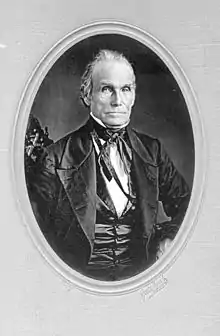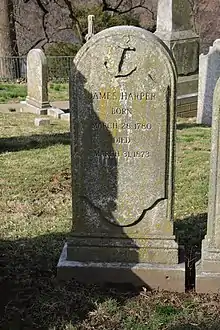James Harper | |
|---|---|
 James Harper around 1870, portrait photograph by Frederick Gutekunst. | |
| Member of the U.S. House of Representatives from Pennsylvania's 2nd district | |
| In office March 4, 1833 – March 3, 1837 | |
| Preceded by | Henry Horn |
| Succeeded by | See below |
| Personal details | |
| Born | March 28, 1780 Castlederg, County Tyrone, Kingdom of Ireland |
| Died | March 31, 1873 (aged 93) Philadelphia, Pennsylvania, U.S. |
| Resting place | Laurel Hill Cemetery, Philadelphia, Pennsylvania, U.S. |
| Political party | Anti-Jacksonian |
James Harper (March 28, 1780 – March 31, 1873) was an Irish-American politician who served as a National Republican member of the U.S. House of Representatives for Pennsylvania's 2nd congressional district from 1833 to 1837.
He owned a brick manufacturing business, a wholesale grocery trade and developed the Philadelphia neighborhood now known as Rittenhouse Square.
Biography
Harper was born on March 28, 1780, in Castlederg, County Tyrone in Ireland. As a youth, he immigrated to the United States with his parents, and settled in Philadelphia.[1] He rose to prominence in commerce through the manufacture of brick and from 1820 to 1830 in the wholesale grocery trade. He married Charlotte Sloan Alford, a member of an established Pennsylvania Quaker family. He was a Freemason, and was elected to the position of Grand Master of Pennsylvania in 1824.[2] As Grand Master, he hosted fellow mason the Marquis de Lafayette during the latter's "Farewell Tour" of the United States in 1825.[3]
In 1832 Harper was elected to the United States Congress as a National Republican (Anti-Jacksonian), and represented Pennsylvania's Second Congressional District in the Twenty-third and Twenty-fourth Congresses. His letters from Washington, some of which are preserved in the Historical Society of Pennsylvania, reflect a disgust with the endemic corruption of Andrew Jackson and his administration. He chose not to stand for reelection in 1836. In Congress he allied himself with Henry Clay, and followed Clay in commissioning his portrait from the Philadelphia painter John Neagle.[4]

Upon his retirement from Congress, Harper continued in the manufacture of brick, and branched out into real estate speculation and urban development. He bought the north side of Philadelphia's then undeveloped Rittenhouse Square and built a fine house for himself at 1811 Walnut Street in around 1840. His mansion set a patrician residential tone for the square and he sold off the remaining lots at profit. The front part of his house, sold after his death to the Social Art Club (an exclusive men's club that renamed itself the Rittenhouse Club),[5] still stands behind the 1901 facade that the club added.[6]

In Philadelphia Harper was a member of the Board of Guardians of the Poor and of the Board of Prison Inspectors.[1] A patron of science, Harper was one of the founders of the Franklin Institute in 1824,[7] and a delegate to the Great Exhibition of the Works of Industry of all Nations (often called the "Crystal Palace Exhibition") in London in 1851. Harper was a pewholder at St. Stephen's Episcopal Church.[3] He died in Philadelphia on March 31, 1873, and was interred in Laurel Hill Cemetery.[1]
Legacy
The Harper, a 24-story luxury apartment[8] and Harper's Garden, a bar and restaurant, both in the Rittenhouse Square neighborhood of Philadelphia, were named in his honor.[9]
Of his ten children, eight survived to adulthood and several of those entered public life: Alexander J. Harper was President of the Philadelphia City Council, Benjamin West Harper (named after Charlotte Harper's relative Benjamin West) was a businessman and lieutenant colonel in the Pennsylvania National Guard, and Thomas Scott Harper was a physician and president of the Medical Board of Philadelphia.[10]
Citations
- 1 2 3 "Harper, James 1780-1873". www.bioguide.congress.gov. Biographical Directory of the United States Congress. Retrieved February 23, 2022.
- ↑ Row, Augustus (1868). Masonic Biography and Dictionary. Philadelphia: J.B. Lippincott & Co. p. 126. Retrieved February 23, 2022.
- 1 2 Heinzen, Nancy M. (2010). The Perfect Square: A History of Rittenhouse Square. Philadelphia: Temple University Press. pp. 22–23. ISBN 9781592139897. Retrieved February 24, 2022.
- ↑ Burke, Bobbye and Trina Vaux (1985). Historic Rittenhouse, a Philadelphia Neighborhood. Philadelphia: U of Pennsylvania, 1985. Philadelphia: University of Pennsylvania Press.
- ↑ Skaler, Robert Morris; Keels, Thomas H. (2008). Philadelphia's Rittenhouse Square. Charleston, SC: Arcadia Publishing. p. 16. ISBN 978-0-7385-5743-4. Retrieved February 24, 2022.
- ↑ Heinzen, Nancy M. (2010). The Perfect Square: A History of Rittenhouse Square. Philadelphia: Temple University Press. pp. 29–31. ISBN 9781592139897. Retrieved February 23, 2022.
- ↑ Jenkins, Howard Malcolm; Seilhamer, George Overcash (1895). Memorial History of the City of Philadelphia. New York: New-York History Company. p. 457. Retrieved February 23, 2022.
- ↑ "The Harper - Pearl Properties". www.pearl-properties.com. Pearl Properties Commercial Management, LLC. Retrieved February 24, 2022.
- ↑ "Harper's Garden". www.photos.discoverphl.com. Philadelphia Convention & Visitors Bureau. Retrieved February 24, 2022.
- ↑ Campbell, John Hugh (1892). History of the Friendly Sons of St. Patrick and of the Hibernian Society for the Relief of Emigrants from Ireland. Philadelphia: The Hibernian Society. pp. 423–424. Retrieved February 24, 2022.